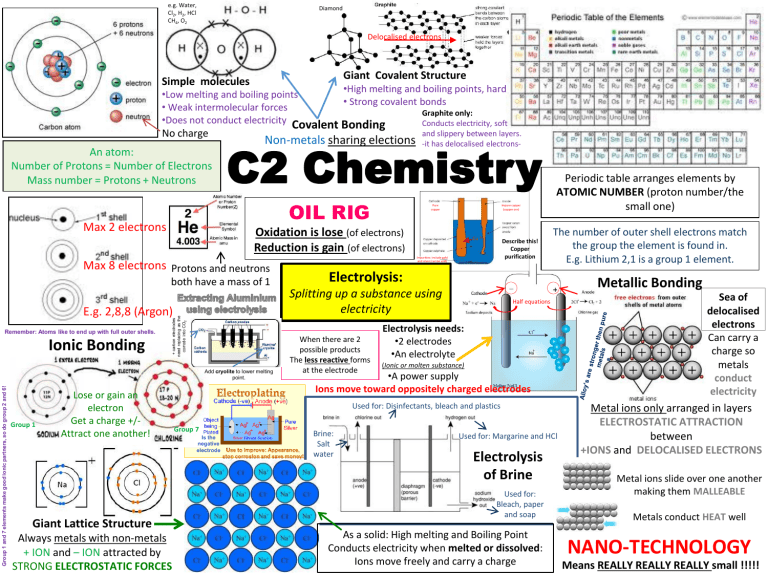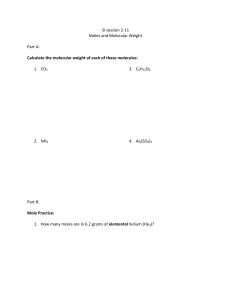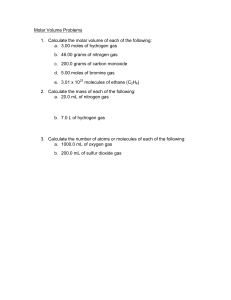C2 Chemistry Study Notes: Bonding, Electrolysis, Formulas
advertisement

e.g. Water, Cl2, H2, HCl CH4, O2 Diamond Delocalised electrons Giant Covalent Structure Simple molecules •High melting and boiling points, hard •Low melting and boiling points • Strong covalent bonds • Weak intermolecular forces Graphite only: •Does not conduct electricity Covalent Bonding Conducts electricity, soft No charge An atom: Number of Protons = Number of Electrons Mass number = Protons + Neutrons Non-metals sharing elections C2 Chemistry OIL RIG Max 2 electrons both have a mass of 1 + carbon electrodes need replacing as the corrode into CO2 E.g. 2,8,8 (Argon) Ionic Bonding Group 1 and 7 elements make good ionic partners, so do group 2 and 6! Add cryolite to lower melting point. Group 1 Pure copper Impure copper (copper ore) Oxidation is lose (of electrons) Reduction is gain (of electrons) Max 8 electrons Protons and neutrons Remember: Atoms like to end up with full outer shells. and slippery between layers. -it has delocalised electrons- Lose or gain an electron Get a charge +/Attract one another! Giant Lattice Structure Always metals with non-metals + ION and – ION attracted by STRONG ELECTROSTATIC FORCES Cu 2+ Describe this! Copper purification Impurities: include gold and silver (can be sold) Periodic table arranges elements by ATOMIC NUMBER (proton number/the small one) The number of outer shell electrons match the group the element is found in. E.g. Lithium 2,1 is a group 1 element. Electrolysis: Metallic Bonding Splitting up a substance using electricity When there are 2 possible products The less reactive forms at the electrode Half equations Electrolysis needs: •2 electrodes •An electrolyte (Ionic or molten substance) •A power supply Ions move toward oppositely charged electrodes Used for: Disinfectants, bleach and plastics Group 7 Is the negative electrode Brine: Salt water Used for: Margarine and HCl Electrolysis of Brine Used for: Bleach, paper and soap As a solid: High melting and Boiling Point Conducts electricity when melted or dissolved: Ions move freely and carry a charge Sea of delocalised electrons Can carry a charge so metals conduct electricity Metal ions only arranged in layers ELECTROSTATIC ATTRACTION between +IONS and DELOCALISED ELECTRONS Metal ions slide over one another making them MALLEABLE Metals conduct HEAT well NANO-TECHNOLOGY Means REALLY REALLY REALLY small !!!!! Other techniques: Gas chromatography for separation, Mass Spectroscopy for identifying and finding molecular mass. Experimental Analysis -Identifying what’s in a mixture. Paper chromatography Molecular ion peak = peak with the largest mass Relative formula Mass ISOTOPES Add the mass of each atom in the are atoms of the same element with formula together different numbers of neutrons e.g. CaCO3 Why use a machine? 40 + 12 + 16 + 16 + 16 = 100 Advantages Disadvantages •Quick • Accurate •Analyse small amounts •Expensive •Needs special training •Interpreted by comparison only Additives improve appearance, taste and make food last longer! Hand warmers and self heating cans use exothermic reactions. Mixing two chemicals to produce heat (single use) or the formation of crystals in a supersaturated solution (reusable). I’d love to tell you a good chemistry joke but all the good ones Argon We compare the mass of any atom to Carbon 12 Moles Plastics Using different monomers and conditions will change the type of polymer you produce. Cool packs use exothermic reactions – Good for sport injuries! 1 mole of any substance contains the same number of particles. (6.02x1023) Relative atomic mass or formula mass in grams is equal to one mole. e.g. 12g of carbon is one mole of carbon Mass of element Total mass of compound x 100 = Percentage Mass e.g. % mass of carbon (12) in ethane C2H6 (30) 24 / 30 x 100 = 80% Exothermic reactions give out heat to the surroundings(get hotter) e.g. Respiration & Combustion Endothermic reactions take in heat from the surroundings (get colder) e.g. Photosynthesis When a reaction forms a SOILD(s) its called a PRECIPITATE Catalysts • • • Too removed a solid (s) from a reaction you FILTER it out ! - speed up reactions without being used up Increasing the rate of a reaction can save money! Different reactions need different catalysts! Catalysts are often metals If you reaction gives you a dissolved product (aq) instead, you EVAPOURATE it out ! (if they escape they might harm the environment) e.g. Sulfuric Acid + Magnesium -> Magnesium sulfate+ Hydrogen e.g. Nitric Acid + Copper Oxide -> Copper nitrate + Water Salt For this: Anything that's not a metal on its own is a base Hydrochloric Acid Chloride Salt + Hydrogen Salt + Water Sulfuric Acid Sulfate Nitric Acid Nitrate Acid + Metal Acid + Base Acids & Bases (Alkalis) Acids – H+ Alkalis – OHBases NEUTRALISE acids Alkalis are soluble bases The rate of a reaction is speed up by increasing the: •Temperature •Surface area •Concentration •Or by adding a CATALYSIS Increase in pressure is the same as increase in concentration An increase of 10oC doubles the rate of a reaction pH Scale Find the pH using Universal Indicator When we increase the concentration/surface area we increase the frequency of particles colliding and reacting. Speeding up the reaction. When we increase the temperature the particles move faster, they are more likely to collide and do so with sufficient energy to react. Speeding up the reaction. IMPORTANT Acid Collision Theory We can measure the rate of a reaction by looking at how fast solid reactants are used up, how quickly gas is produced or how quickly light is blocked (the disappearing cross) For a reaction to take place we have to have the minimum amount of energy needed The ACTIVATION ENERGY Balanced Equations Percentage Yield This is used to compare our actual yield with our theoretical yield. Molecular Formula : The actual number of atoms of each element in an individual molecule Amount of product actually produced Maximum possible yield (Theoretical yield) x 100 Empirical Formula : The simplest whole number ratio of the elements in the molecule Calculating the Empirical Formula 1) Use the same table and method given for calculating reacting masses but remove the ratio row. The question will either provide the grams of each element or the percentage. Assume percentages are the same figure in grams. e.g. 12% = 12g Question: A substance contains 24% carbon and 64% hydrogen. Calculate the its empirical formula. Chemical Carbon Hydrogen Grams 24 64 Mr 12 16 Moles 2 e.g. 200 275 x 100 = 72.73 % A balanced equation has the same number of atoms for each element on both sides Its rare to get 100% yield This is because some products can be left in apparatus or separating products from reactants is difficult. Sometimes it’s not everything reacts to begin with. We can use this to find the ratio of moles that are needed to react with one another e.g. 1 CH4 molecule reacts with 2 O2 molecules 1:2 ratio When doing an experiment if we know the grams used and the Molecular/Formula Mass we can calculate the moles e.g. In 24 g of carbon which has an Mr of 12 there would be 2 moles of carbon. 24/12 = 2 Working out chemical formula… This is useful if we want to calculate how much product we would get from a specific amount of reactant g Grams THEORETICAL YIELD n Moles Mr 2/2 = 4/2 = 1 : 2 This gives you the number of each element present and the empirical formula C H2 If you were told the compound had a mass of 28 you could calculate the molecular formula The Mr of CH2 is 14 28 /14 = 2 Therefore the molecular formula must be double the empirical one C2H4 Question: How much CO2 would be produced by burning 100g of Methane (CH4) ? 1) Put in the things you already know. You were given the grams of methane in the question. And can calculate the Mr using the periodic table. Chemical CH4 CO2 Ratio 1 1 Grams 100 ? Mr 16 44 Moles 6.25 6.25 2) Use the triangle to 3) Use the ratio from balanced equation to provide the calculate the moles or moles of CO2 methane used. 1:1 6.25 : 6.25 The charges should always cancel out! Ag+ and Calculating Theoretical yield 2) To get the simplest ratio divide all moles by the smallest calculated value When you need to work out the ionic formula of a substance you will always need something from the positive ion column and something from the negative ion column. e.g. What is the formula for silver oxide? 1) First identify the two ions you need. (one from each column) Molecular/ Formula Mass 4 Use your data sheet! O2- 2) Balance the charges. Oxygen has 2 minus charges but silver only has a single positive charge. This means you’ll need two silvers to cancel out the one oxygen. ( + + ) Ag+ Ag+ = O2- ( - - ) What if you need 3) Write the formula. When you know how many of each ion you need use this in the formula and ignore the charges. Ag2O Try to work out: Magnesium oxide and Calcium chloride… 4) Now you have the Mr and the moles of CO2 you can use the triangle to calculate the grams that will be produced. 44 x 6..25 = 275 Answer: 100g of methane would make 275 g of CO2 something that already has a small number? Put the whole ion in brackets! Cu (NO3)2 Answers: MgO CaCl2 Molecular Formula & Empirical Formula All figures in example calculations refer to the burning of methane in oxygen as shown in the balanced equation




